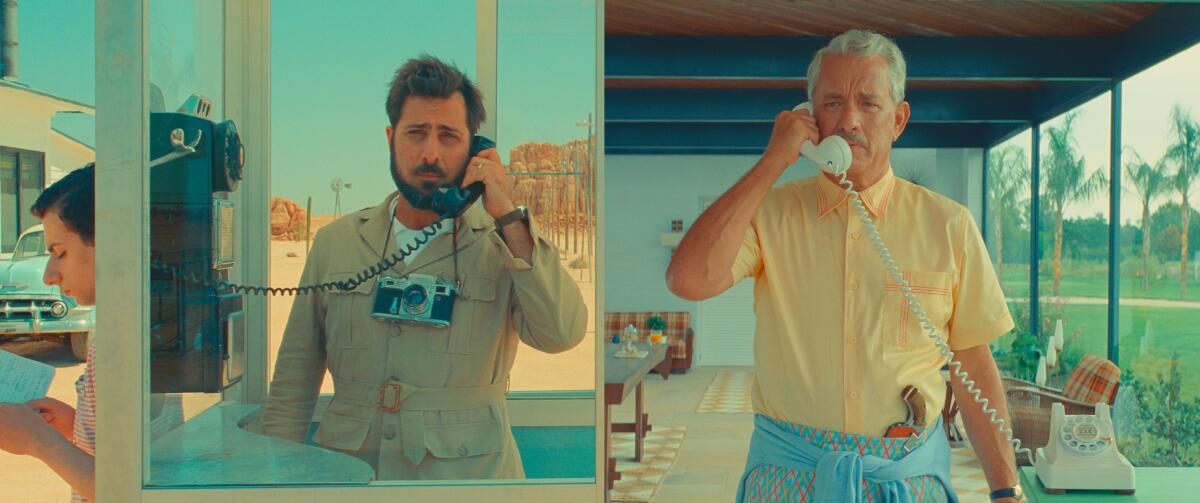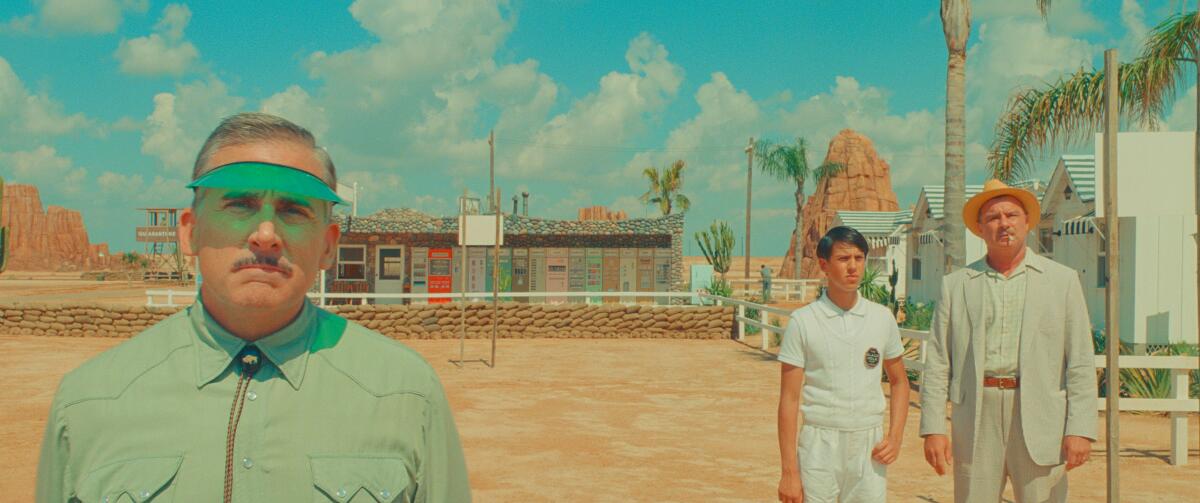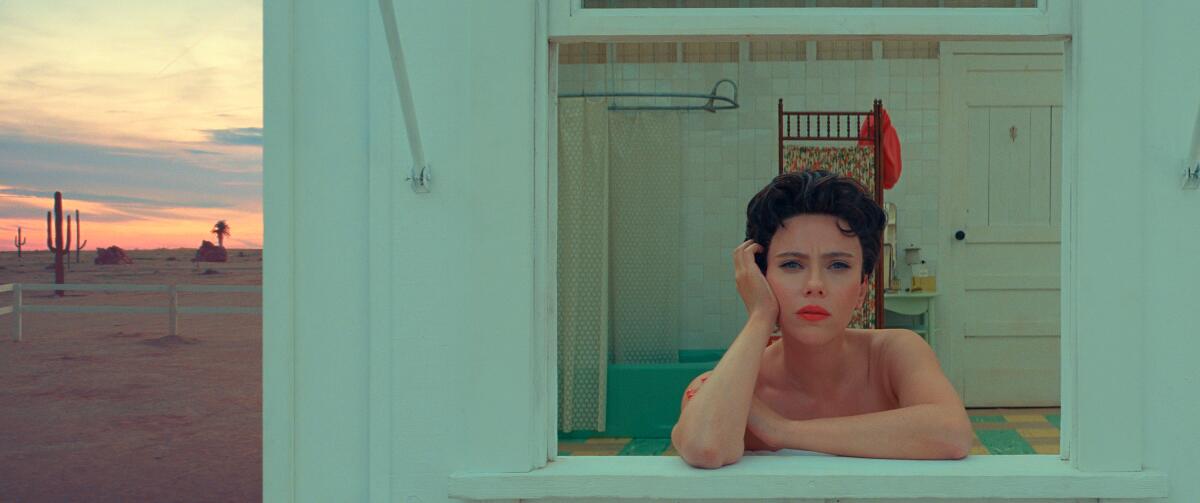Review: Wes Anderson’s gorgeous ‘Asteroid City’ is more starry than stellar

- Share via
“Asteroid City,” Wes Anderson’s half-irritating, half-intoxicating desert bloom of a movie, unfolds mostly in 1955 in a small Southwest town — a postcard-perfect oasis surrounded by cactuses, red rocks and vast horizons.
Our first glimpse of it is deeply transporting: No sounds break the silence, and no actors (or tumbleweeds) disrupt the vast spaces of Robert Yeoman’s impeccably framed widescreen compositions. Instead, the camera nimbly rotates nearly 360 degrees, pausing mid-pan to register the glories of Adam Stockhausen’s Wild Wild Wes production design: a diner, a motel, a filling station, a highway ramp to nowhere. That last one is a symbol: of unrealized promise, yes, but also of the-sky’s-the-limit possibility.
Welcome to Asteroid City, a gorgeous piece of scenery even by Anderson’s standards and an open-air museum of antiquarian delights, with its 40-cent milkshakes, vintage vending machines and pastel-hued automobiles. It is also, at this early stage, a museum happily devoid of visitors. Not that you’ll mind when Jason Schwartzman, Scarlett Johansson, Tom Hanks, Tilda Swinton, Jeffrey Wright and other familiar and newly minted members of Anderson’s company turn up, bringing with them a swirl of persnickety, precisely choreographed human activity. But there’s something captivating about that early stillness: Asteroid City, we see, is not just a town but a carefully constructed set, and not just a carefully constructed set but the scaffolding for a typically elaborate formal and narrative conceit.
The conceit itself is by turns intriguing and laborious, and depending on your willingness to unpack it, it will be either the revelation that sends this movie soaring into the stratosphere or the heavy stone that drags its featherweight pleasures down to earth. (My first go-round, at last month’s Cannes Film Festival, tended frustratingly toward the latter; a second viewing proved eye-opening, if a few pans short of a 180-degree reversal.) “Asteroid City,” you see, is not just a movie we’re watching but a “hypothetical play,” in the words of a genial host-narrator (Bryan Cranston), that’s being staged and produced for 1950s television.

It’s an archly overarching framing device delineated by boxily framed black-and-white images and given prominent positioning throughout Anderson’s two-act screenplay (drawn from an idea conceived with his regular collaborator Roman Coppola). Early on, we meet some of the creative forces behind this production, including a Tennessee Williams-ish playwright (Edward Norton) and an Elia Kazan-esque director (Adrien Brody). And then there’s the cast, which is where things get especially meta-tortured: Schwartzman, Johansson, Hanks et al. are actors playing actors (in black-and-white), but they are also actors playing actors playing characters (in color).
For simplicity’s sake, let’s leave aside the behind-the-scenes stuff and treat the play as the thing, which the movie for the most part does. Schwartzman, bearded and moody, is a war photographer named Augie Steenbeck — a surname he shares with the old flatbed editing machines of Hollywood yore, in keeping with this movie’s obsessive retrophilia. He pulls into Asteroid City in a rickety station wagon with three adorably witchy daughters (Ella, Gracie and Willan Faris) and a brainy teenage son, Woodrow (Jake Ryan), who’s receiving a prize at the town’s annual Junior Stargazers and Space Cadets convention.
You’ll do plenty of stargazing yourself during “Asteroid City,” and not just of the celestial variety. That’s Steve Carell puttering away as the motel’s eager-to-please manager, busily preparing rooms for various harried convention guests played by Liev Schreiber, Hope Davis and Stephen Park. Matt Dillon tools around in an auto garage, Maya Hawke teaches a class of science whizzes, and Rupert Friend sings, plays the guitar and wears beautifully stitched denim.
The most glamorously aloof visitor is Midge Campbell (Johansson), a movie star who’s an amalgam of different movie stars — she’s Ava Gardner, Marilyn Monroe and Kim Novak, though seldom all at once — and who has a Junior Stargazer daughter of her own, Dinah (Grace Edwards).
Youthful precocity is a given in Anderson’s movies, as are the stirrings of young love. Woodrow, who soon falls for Dinah, is spiritual kin to the love-struck teenagers in “Moonrise Kingdom,” the neglected geniuses of “The Royal Tenenbaums” and, most of all, the thwarted romantic hero of “Rushmore,” and not just because Schwartzman, who made his screen debut as Max Fischer 25 years ago, is playing his dad.

The Steenbecks themselves are a classically Andersonian fractured family, fluent in the filmmaker’s familiar language of deadpan-melancholy pronouncements but less adept at direct communication. Augie hasn’t yet managed to break the news to his kids that their mother died recently after a long illness. Nor does he have the words to win over his disapproving father-in-law (Tom Hanks, in an affectionate growl of a performance), who comes to Asteroid City to spend some time with his grandchildren.
All this family drama unfolds against a backdrop that, with its local observatory and historic meteorite crater, thrums with technological innovation and postwar possibility. Anderson takes obvious delight in his characters’ ingenuity, mainly because it can serve as a conduit for his own. But that delight is also tempered by anxiety and alarm. If Woodrow and his fellow junior astronomers represent the next generation of scientific minds, the ominous mushroom clouds rising from atomic-test sites suggest something much darker on the horizon. In time, a flying saucer will zip into view, bringing the story’s first act to a close and sending Asteroid City into government-imposed lockdown. As usual, Anderson hurls his characters into a collective crisis that gives rise to individual bursts of resistance and reconciliation.
All of which would be more than enough to occupy your attention even if the movie slowed its tempo, attenuated its gags or paused to give each actor more than a drolly robotic witticism or two. (Blink and you’ll miss Bob Balaban and an especially underused Hong Chau.) But the director, operating by his own laws of compression and acceleration, instead piles layer upon Brechtian layer. In movies like “The Grand Budapest Hotel” and, more recently, “The French Dispatch,” he has insisted on nesting stories within stories, chasing intricate narrative structures that draw on literary and cinematic inspirations alike.
In “Asteroid City,” he adds a third and perhaps even a fourth representational mode to the mix: By focusing on the interlocking worlds of theater and television, he turns an eerie extraterrestrial action-comedy into a series of close encounters of the thespian kind. Even as Asteroid City the fictional town is rocked by alien visitations, “Asteroid City” the TV production must weather its own cataclysms behind the scenes. Anderson and his performers pay witty, self-conscious homage to the groundbreaking work of the Actors Studio in the 1950s — a moment when the heightened theatricality of Old Hollywood was giving way to the subtler psychological realism of the Method.

Method acting, of course, could scarcely be more antithetical to Anderson’s own rigidly mannered performance style, which makes “Asteroid City” a fascinating, sometimes brain-melting collision of aesthetic modes. For Anderson’s admirers — and I count myself among them half the time — that style is a deliberately self-imposed obstacle, one that doesn’t conceal so much as magnify the emotions that his characters feel but can never properly express. On that logic, is it a flaw that so many of the great if familiar faces in this ensemble leave so little impression? Or is it a kind of trade-off, one that allows the movie’s two stellar leads, Schwartzman and Johansson, to leave as poignant an impression as they do?
One of the movie’s most wistfully lovely scenes finds Augie and Midge carrying on a window-to-window conversation from neighboring motel rooms, discussing their lives, their losses and especially their art. Their professional commiseration tilts into a kind of chaste (at first) seduction; in Anderson’s world, what people do is all but inextricable from who they are. The scene becomes more affecting still when it’s echoed, sometime later, outside a New York soundstage — and you begin to see, if only for a moment, the meaning in Anderson’s relentless visual and narrative symmetries, the beauty in his incessantly toggling design.
Scientists and artists, he suggests, are driven and indeed united by the same restlessly inventive spirit, the same desperate desires for human connection. That notion admittedly comes together more coherently in your head afterward than it does on the screen in front of you, which isn’t necessarily a knock. Some great movies do play better in the memory, even if “Asteroid City,” light-fingered and leaden by turns, never quite ascends into their company. It soars, stalls and sometimes alienates. It also lands on a conclusion as moving as it is undeniable: We are not alone.
‘Asteroid City’
Rating: PG-13 on appeal, for brief graphic nudity, smoking and some suggestive material
Running time: 1 hour, 44 minutes
Playing: Starts June 16 at AMC Burbank 16; AMC Burbank Town Center 6
More to Read
Only good movies
Get the Indie Focus newsletter, Mark Olsen's weekly guide to the world of cinema.
You may occasionally receive promotional content from the Los Angeles Times.











